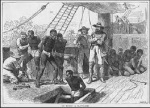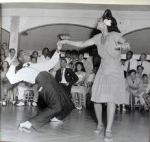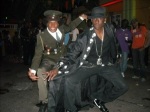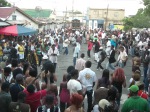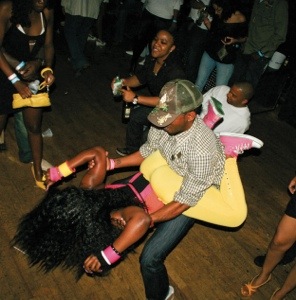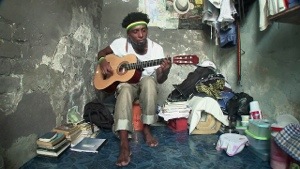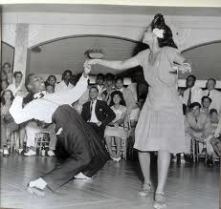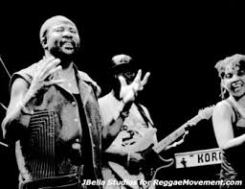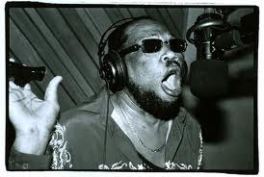A round up of recent news reports on what is arguably Jamaica’s best one night show suggests Jamaican music fans, dancehall in particular, are in for a ‘higher level, boombastic, so special, guh hard an’ done’ performance! Afterall, Downsound is back on board for Sting 2013 following the exciting partnership for the 2012 staging; Mavado who is hot from his recent collab with Nicki Minaj is set to take the stage; Super Cat, 2Chainz will headline adding retro dancehall pedigree and an international flavour to the line-up ; and, the show is going global to some 315 million targeted across five continents through partnerships with top broadcasters.
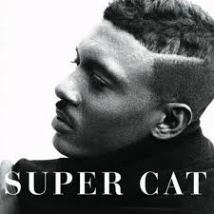 Known for its yearly clashes and hardcore performances, Sting is promising the show of a lifetime befitting the maturity of thirty years in prime form. We will get an appreciation of the old reggae and dancehall styles, the crossovers, the new blood and the clashing too. Sting needs to be commended for maintaining the highly anticipated product for thirty years in spite of economic and other challenges. Joe Bogdanovich of Downsound Records fame has successfully partnered with Supreme Ventures for the staging of Sting 2012 and the partnership returns this year in celebration of the important milestone. Bogdanovich is clear that ‘reggae and dancehall will be shown in a positive light’ and as part of the challenge of achieving high international standards, his mission remains that of uplifting the Jamaican music industry and making shows such as Sting part of the calendar of events visitors come to Jamaica to consume. I am clear, and the promoters are too, that Sting is an asset as a creative product adding to the varied cultural milieu we boast as a nation occupying a dot on the globe.
Known for its yearly clashes and hardcore performances, Sting is promising the show of a lifetime befitting the maturity of thirty years in prime form. We will get an appreciation of the old reggae and dancehall styles, the crossovers, the new blood and the clashing too. Sting needs to be commended for maintaining the highly anticipated product for thirty years in spite of economic and other challenges. Joe Bogdanovich of Downsound Records fame has successfully partnered with Supreme Ventures for the staging of Sting 2012 and the partnership returns this year in celebration of the important milestone. Bogdanovich is clear that ‘reggae and dancehall will be shown in a positive light’ and as part of the challenge of achieving high international standards, his mission remains that of uplifting the Jamaican music industry and making shows such as Sting part of the calendar of events visitors come to Jamaica to consume. I am clear, and the promoters are too, that Sting is an asset as a creative product adding to the varied cultural milieu we boast as a nation occupying a dot on the globe.
First held at Cinema 2 in New Kingston in 1984, I have attended a number of its stagings at Jamworld. Last year, I said this about its 29th staging and I can only hope that my concerns about the product will be heard.
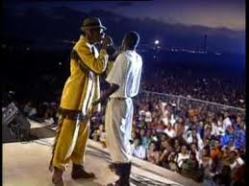
The Best Ever Sting? What Did 2012 Bring?
On the heels of all the successful events in 2012, with Shabba’s Sumfest appearance as my massive moment, the big end of year buzz resided with Sting in the face of a declining dancehall calendar of events for December. This year the anticipation levels were locked in because on a platter was given the release of highly anticipated Busy Signal from a six month sentence served in a Federal United States prison. On that same platter was the hottest DJ of the year Konshens who fortuitously had a date cancellation. Then there was the devil-devouring lot, long awaiting the chance to pour holy water on Uncle Demon (aka Tommy Lee), while Macka Diamond and Spice heated it up over who was blacker!!? In other words, Sting, long known for and successfully retaining its place as the last bastion of the Jamaican dancehall clash performance mode, and dubbed the greatest one night show in Jamaica, had it good for the 2012 edition. Add to this the Supreme Promotions alliance with don of Downsound Records Josef Bogdanovich signalling new levels of cooperation, needed capital and media ops for ‘slapping cash’ into the hands of desired acts.
The line-up was enormous. I wanted to hear Busy Signal, Konshens, Mavado (who did not appear), Macka Diamond and Spice who didn’t clash afterall, and Ninja Man in particular. I expected Kiprich to deliver in his usual style and I was anticipating what the wrestling-labelled tag team clash would bring. But what did 2012 really bring? Some seem to be following the hype when hot air has in fact turned cold.
I arrived at the venue around 1:30am in somewhat of a panic because patrons were encouraged to arrive for the 12:30am appearance by Busy Signal. Well, recognising that Specialist was the act in performance, my heart settled and I decided to walk the venue from back to front, and side to side to check out the mood, fashion, those familiar faces and of course the security in place. By the time I settled into the crowd it was time for Etana who delivered in usual appealing style with tunes such as Roots, Wrong Address and Wifey.
The 2012 edition of Sting was divided into six categories, and if I must say so myself, a fine compendium of choices for a one night show. These were 12 Disciples of Dancehall, Best of Reggae, Independent Ladies, the Fantastic Four (Nature, Droop Lion, Iba Mahr and Chronixx), Three the Hard Way and Next Generation.
After Etana, the next time my focus reached the stage was for the announcement of Chronixx who is now seen as the next big act out of Jamaica: consummate performer, bright, lyrically adept, genre flexible, settled and has his goal squarely in front of him. I was then impressed by Nature, an act I was seeing for the first time who used the stage admirably with his conscious Rastafari-inspired contribution. Then, soon enough Romain Virgo did not disappoint. I’ve been paying attention to him, seeing him mature, watching his management choice and waiting for his next releases.
Around 3:36am when Busy Signal was being introduced by the studio recording Michael Anthony Cuffe so ably delivered, I got in gear for the performance I had anticipated. I quickly left the VIP area and settled into the crowd again because some performances have to be experienced in the midst of the most energised crowd constellation, what Kamau Brathwaite refers to as ‘congregational kinesis’.
So much was right about Busy’s performance. His oratory on prison life interspersed between timeless selections such as ‘Nah Go a Jail Again’ was masterful. It was Busy’s year at Sting 2012: hijacked from a flight on his way from Britain, incarcerated and having suffered many a nutrition and other woes behind bars, Busy’s maturity and professionalism was evident. We were treated to new releases, a fine tribute to Buju with Dean Frazer on saxophone, plus the gospel medley with a children choir dressed in full white. Busy Signal signalled his heroic status in dancehall and his delivery went a long way for securing more street love among two important blocks – the christians and the Buju fans who are impatiently anticipating his release. When his set was completed, in fitting style, Busy was presented with the Game Changer Award by Joe Bogdanovich.
Konshens my other favourite touched the stage at 4:37am dressed in what was trendy athletic / casual gear, with delivery typical of his successful year as he performed crowd favourites such a ‘Gyal Sidung’ featuring Darrio who is getting his much needed break alongside Konshens.
It wasn’t until daylight that the anticipated Uncle Demon, Tommy Lee Sparta hit the stage to deliver what seemed to be a well rehearsed set backed by Ruff Kutt Band. Though one perceived by many to be in need of holy water there were no attempts to perform any exorcisms either by Ninja Man, Bounti Killa (absent from Sting 2012) or I Octane. Of course his red and black outfit signalled confidence and hard core competence based on the year-long success he enjoyed.
In true Sting fashion, orchestrated or not, the popular Popcaan of Gaza camp fame had his set interrupted by Black Ryno’s appearance on stage which he announced with some obviously troubling Gaza loyalty invocations. Word on the street is that they are no longer members of Kartel’s Portmore Empire, but curiously street credibility relies on paying homage to such musical edifices. Ryno walked on stage during Popcaan’s set which triggered pushing and the movement of much security personnel to the stage. No one was either visibly or reported hurt but Popcaan was quickly asked to depart, the last of him being seen with a mob moving out of the venue. The task was then left to I Wayne and Lutan Fyah to pour lyrical water on the various factions and fiery atmosphere left by the skirmish.
I decided to leave at this point, daylight, in fact way past dawn, approximately 6:45am, for a number of reasons. On my way home, approximately 7:10am I was hearing reports of Sizzla’s performance and the fact that he did not disappoint. My decision to leave had less to do with security and safety than with my disappointment in the fact that as one of the greatest one night shows in Jamaica, and in its 29th staging over 28 consistent years, the organisers of Sting have still given themselves wiggle room for mediocrity.
So much was problematic because performances alone have never a stage show made. A great line-up was essentially sacrificed by less than perfect stage management, security inadequately deployed especially after the announcement that the show had moved into the clash segment, and a running order which was not managed, therefore not delivering a consistently created crescendo effect. No excuse can explain why great acts didn’t touch the stage by 6:45am. One good thing which stood out for me in terms of the organisation and character of the show was the short band changes.
When I tried to express my feelings about Sting 2012 I was greeted with the following responses:
“But Sting’s aesthetic is not intended to get it completely right anyway…ghetto people something is always evolving – unpredictable and thus not for those expecting the Jazz and Blues type of catharsis…” JS
“But that is STING. For dancehall it was pristine.” NS
In other words, “that’s just Sting”. There is a culture that’s unique and that also means one should accept mediocre standards in a context where we are building / maintaining a reputation as world musical superpower. But in such a context, is there room for mediocrity? If controversy is the aim, then certainly one can strive to be at the top of even that game. The fact that there is a link between events held in Jamaica and the ‘heads to beds’ number outcomes for the Ministry of Tourism and ultimately the country’s foreign exchange piggy bank is also another point for consideration. Whether we know it or not, major music events drive visitor arrivals up and we must remain cognisant of viewing this one night show as a catalyst for greater cultural and economic development in a holistic sense. Realistically, how many patrons really walked away thinking that they left the show on a high, having got their money’s worth? I certainly didn’t.
Finally, my question having missed the tag team clash is — why would Tony Matterhorn have agreed to team up with tired Merciless in the first place, and to go gladiator style with veteran Ninja Man and adept Kiprich at that?? Hah sah.


